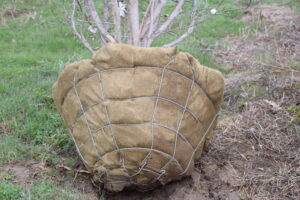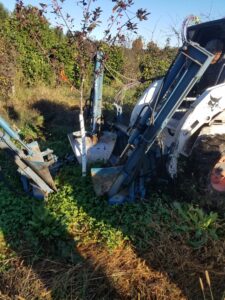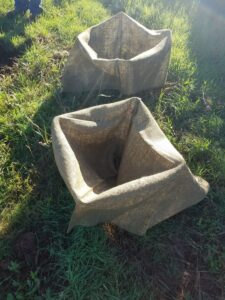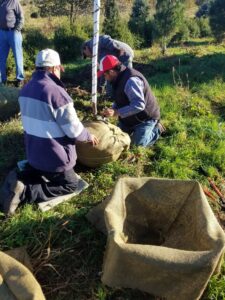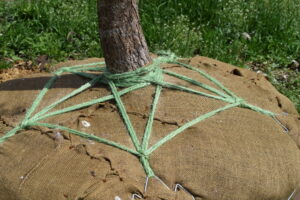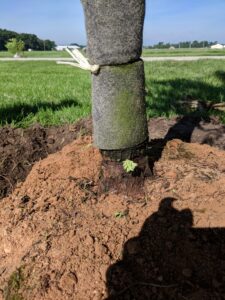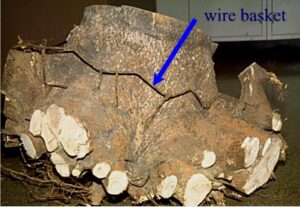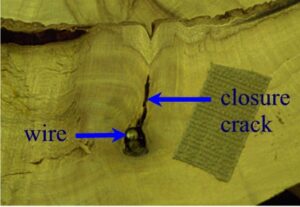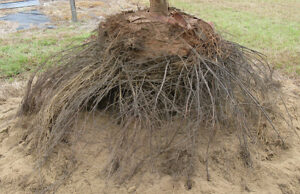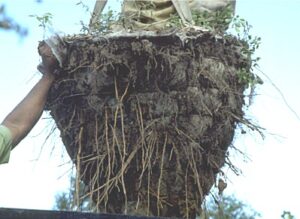There are many age-old, philosophical questions that people have been arguing over for many years. What is the meaning of life? Nature or nurture? Do aliens exist? Should I remove the wire and burlap from B&B plant material? The last question has been debated for many years, with almost everyone having a different opinion.
- Figure 1. Wire baskets with burlap have allowed large plants to be transplanted into the built landscape efficiently and successfully.
There are many recommendations, almost exclusively based on anecdotal evidence, from Green Industry professionals regarding the proper way to treat balled-in-burlap plants. These recommendations range from leaving everything intact, to removing all of the packaging material.
Wire baskets are an indispensable product for the Green Industry. The introduction of wire baskets allowed larger trees to be planted successfully with much less transplant shock compared to previous methods.
- Figure 2. A mechanical digger on a skid steer digging a tree with a spade attachment.
- Figure 3. A wire basket with burlap ready for packing a tree.
- Figure 4. Nursery employees packaging a freshly dug tree.
By removing the wire and burlap, most of the root ball will become loose or break apart. This situation is the equivalent of planting a bare root plant, which typically will have a significant amount of transplant shock and require multiple seasons of staking and watering. This also significantly increases time to install (Koeser, et.al., 2015).
On the other hand, by leaving the wire and burlap will increase transplant success and minimize staking. The concern for leaving the packaging material intact is the potential restriction of roots as the plant grows out of the original root ball.
All parties agree that removing all twine around the trunk and root ball is necessary. Many times twine is synthetic, thus doesn’t break down in an acceptable amount of time. The same is true for synthetic or treated burlap, but these aren’t used as much currently.
- Figure 5. Remove all twine from the trunk and basket after placing into planting hole.
- Figure 6. Remove twine and burlap from the top of the root ball to find the root flare.
The debate between leaving the wire basket intact vs. removing is essentially a debate between successful transplanting (leaving on the wire) vs. long-term health (removing the wire). This debate is most common between nurseries/installers and arborists, which can create a negative view from the arborists of the installers/nurseries (Appleton and Floyd, 2004).
There has been a limited amount of data on this issue due to the long-term nature of the research, and the difficulty in elucidating stress/death from the wire basket or some other factor (i.e. planting depth, soil conditions, etc.). Traditionally the thought was for initial transplant success that leaving the wire basket and burlap, at least partially, is the best method. A recent study by Koeser, et.al. (2015) on Norway maple and honeylocust indicated no difference on early growth between wire intact vs. wire removal. There was a significant difference in root ball condition and time for installation two to three years after planting. Since this trial was conducted with nursery soil, there might be differences when planted into the built environment.
The research on the long-term success of plants with wire baskets left intact is mixed. This is most likely due to species and site differences. Many plant species (especially faster growing), will envelope the wire in the roots as the roots increase caliper. The most recent work related to long-term (9 years) effects of wire baskets demonstrated marginal differences between removal of wire and burlap, removal of burlap and string, and removing all packaging materials (Klein, et.al., 2019). This study concludes by suggesting removal of wire baskets is not as important as site factors and post-planting care (i.e. watering).
- Figure 7. Large tree enveloping the wire basket. Photo by Dr. Ed Gilman. https://hort.ifas.ufl.edu/woody/root-growth-wire.shtml
- Figure 8. Tree roots growing around wire from basket. Photo by Dr. Ed Gilman. https://hort.ifas.ufl.edu/woody/root-growth-wire.shtml
Appleton and Floyd (2004) summarized the recommendations from major arboricultural references.
Table 1. Wire basket handling recommendations of major arboricultural references. Modified from Appleton and Floyd (2004).
| Reference | Author | Publication Date | Recommendation |
| Arboriculture | Harris, Clark, and Matheny | 2004 (4th edition) | ‘Removing the wire from the top 200-300 mm (8-12 inches) of the root ball (depending on size) would be wise for most landscape trees”. “Remove the wire from the top of the root ball”. |
| Arborist’s Certification Study Guide | Lilly | 2001 | “Although it may be impractical to remove the entire basket, it is preferable to cut away as much of the wire as possible, once the tree is in the planting pit and the tree is stabilized”. |
| Pirone’s Tree Maintenance | Hartman, Pirone, and Sall | 2000 (7th edition) | “Wire baskets, essential to lowering the tree into the hole, are no longer needed and wire strands should be cut with a bolt cutter as far down the sides as possible”. |
| Principles and Practices of Planting Trees and Shrubs | Watson and Himelick | 1997 | “All potentially damaging portions of the wire baskets should be removed at planting time.” “To prevent future problems, cut off the top half of the basket before backfilling”. |
| Trees for Urban and Suburban Landscapes | Gilman | 1997 | “Remove the top portion of the wire basket once the root ball is in place”. |
- Figure 9. Root growth from balled-in-burlap root ball. Photo by Dr. Ed Gilman. https://hort.ifas.ufl.edu/woody/root-growth-ends.shtml
- Figure 10. Growth from a root ball after 6-12 months. Photo by Dr. Ed Gilman. https://hort.ifas.ufl.edu/woody/root-growth-ends.shtml
Current, science-based steps to planting a balled-in-burlap plant after in the planting hole:
- Remove and discard all twine around the base of the tree and the basket.
- Pull back burlap from the top of the root ball.
- Remove soil from the top of the root ball to find the trunk flare. If no flare is present (common on conifers), remove the soil to the top most root.
- Remove the top one-third of the wire basket.
- Pull back or remove burlap in the top one-third of the basket.
- Backfill, filling in all air pockets.
- Stake (only if necessary).
Literature Cited:
Appleton, B. and Floyd, S.A. 2004. Wire Baskets-Current products and their handling at planting. Journal of Arboriculture. 30(4). July. Pgs. 261-265.
Klein, R.W., Hauer, R.J., Koeser, A.K., and Bleicher, B. 2019. Impacts of Wire Basket Retention and Removal on Fraxinus americana ‘Autumn Purple’ Growth Nine Years After Transplanting. Arboriculture and Urban Forestry. 45(3): May 2019. Pgs. 79-84.
Koeser, A.K., Hauer, R.J., Edgar, J., Kleinhuizen, D. 2015. Impacts of Wire Basket Retention and Removal on Planting Time, Root Ball Condition, and Early Growth of Acer platanoides and Gleditsia triacanthos var. inermis. Arboriculture and Urban Forestry. 41(1). Pgs. 18-25.
Special thanks to Dr. Ed Gilman, University of Florida. Landscape Plants: https://hort.ifas.ufl.edu/woody/index.shtml
